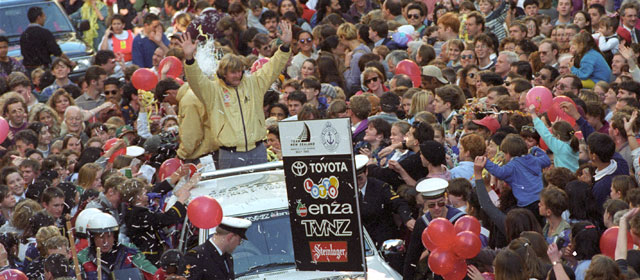Story summary
Since the 19th century, New Zealanders have paraded in the streets to celebrate success or protest against injustice.
Military parades
In colonial times soldiers paraded to show the state’s strength or to encourage men to join the army. When New Zealand fought in overseas wars there were marches to farewell soldiers and to welcome them home again. After wars there were parades remembering battles and heroes. Anzac Day parades every 25 April now include the descendants of those who have fought and died.
Royal visits
When the Duke of Edinburgh visited New Zealand in 1869, thousands gathered to see a member of the royal family. Queen Elizabeth II was the first reigning monarch to visit and received a rapturous reception in 1953–54 – parades and celebrations were held nationwide, and two-thirds of New Zealanders caught a glimpse of the new queen.
School’s out
Schoolchildren and graduating students have paraded in the streets. University students on their annual ‘procesh’ sometimes engaged in wild antics – one group dressed as policemen and made mock arrests. Students also joined protests for peace and against the Vietnam War. Graduation parades have become more formal, while in recent years senior school students have marched against climate change..
Local parades
Communities often celebrated jubilees and anniversaries with parades. In Napier there is an annual art deco parade. Most cities hold a Santa parade in December. Circuses used to parade to drum up business.
Workers’ protests
Workers have taken to the streets to protest about wages and working conditions. From 1890 workers’ parades celebrated the anniversary of the eight-hour working day. Striking workers sometimes faced violent opposition to marches. In Waihī in 1912 striking miners, their wives and children took part in protest marches. Strike-breakers and police stormed the miners’ hall and shot dead a striker. After the government reduced unions’ powers, their influence waned and there were fewer workers’ marches.
Sport
The 1924–25 All Black rugby team won all its games in the northern hemisphere and paraded through city streets on its return. Yachtsmen won the America’s Cup and also got big city parades. Sport caused public displays of rage when protesters marched against the 1981 tour by the South African Springbok rugby team.
Māori land protests
There have been major hīkoi or protest marches by Māori. In the 1975 land march, people walked the length of the North Island and thousands went to Parliament to protest against the loss of land. Loss of Māori legal rights to the foreshore and seabed led thousands to march on Parliament in 2004.





